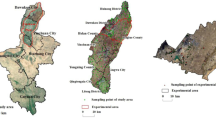Abstract.
Soil water conservation is essential to the sustainability of sandy farming. In this paper, long-term observation of soil water, dry soil thickness and soil chemical changes are evaluated at eight locations in sandy soil. This paper subdivides the sandy lands and deserts of China into three climate zones: arid (hyperarid and extremely arid), semiarid, and humid (subhumid and subtropical humid), with respect to the bioclimatic zone, aridity, soil water content, and soil chemical characteristics. The water movement conditions, and chemical variations in each zone are analyzed. The paper also estimates the spatial and temporal correlation function of arid soil thickness and soil moisture. Sandy soils organic matter content, CaCO3 content, soluble salts content are investigated. Afforestation and selection of tree species in different sandy areas are suggested to regulate sandy land soil moisture. Sandy land in China can be divided into the four sand stabilization regions according to the shifting sand conditions and the techniques advanced: regions I, II, III, and IV. These results have important implications for remote sensing of soil moisture and soil organic carbon, and soil moisture parameterization in climate models.
Similar content being viewed by others
Author information
Authors and Affiliations
Additional information
Electronic Publication
Rights and permissions
About this article
Cite this article
Feng, .Q., Cheng, .G. & Endo, .K. Water content variations and respective ecosystems of sandy land in China. Env Geol 40, 1075–1083 (2001). https://doi.org/10.1007/s002540100269
Received:
Accepted:
Issue Date:
DOI: https://doi.org/10.1007/s002540100269



